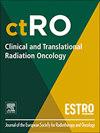Radiotherapy boost to the primary tumour in locally advanced rectal cancer: Systematic review of practices and meta-analysis
IF 2.7
3区 医学
Q3 ONCOLOGY
引用次数: 0
Abstract
Introduction
In locally advanced rectal cancer (LARC), increasing the complete response (CR) rate after total neo-adjuvant treatment may increase the patient eligibility for non-operative management (“watch and wait”, W&W). Although a radiotherapy (RT) boost to the primary tumour may enhance CR rates, clear guidelines are currently lacking. This systematic review and meta-analysis investigate the technical parameters used for rectal boost RT and assess their impact on oncological outcomes.
Methods
Following PRISMA guidelines, the terms “rectum,” “radiotherapy,” and “boost” were searched in PubMed and EMBASE (PROSPERO: CRD42023444685). Studies reporting on external beam RT boost to the primary tumour in LARC and meeting quality criteria were included. Descriptive analyses extracted data on RT technique, preparation, boost delineation, dose, chemotherapy, and follow-up. A mixed-effects meta-analysis model evaluated the impact of selected parameters on CR and local recurrence rate (LRR). Studies were analysed separately based on treatment intent: planned surgery or W&W.
Results
Out of 3904 references, 83 were included in the descriptive analysis and 78 in the meta-analysis. Substantial variability in RT parameters was observed across studies. Pathologic CR rates were significantly higher with intensity-modulated/volumetric-modulated arc RT (IMRT/VMAT, p = 0.007), simultaneous boost (p = 0.020), dose escalation (Biological equivalent dose > 74 Gy, p = 0.035), and the combination of induction and consolidation chemotherapy (p = 0.023). No significant associations were found for clinical CR or LRR.
Conclusion
While rectal RT boost is already part of real-world practices, the wide heterogeneity in techniques highlights the urgent need for standardisation. Our meta-analysis suggests that IMRT/VMAT, simultaneous boost, and dose escalation are associated with higher pathological CR rates and should be considered in future rectal boost guidelines. These findings, however, warrant careful interpretation due to the absence of adjustments for clinical, tumoral, or patient-related parameters that may also influence response rate and oncological outcomes.
放疗对局部晚期直肠癌原发肿瘤的促进作用:实践的系统回顾和荟萃分析
在局部晚期直肠癌(LARC)中,提高完全新辅助治疗后的完全缓解率(CR)可能会增加患者接受非手术治疗的资格(“观察和等待”,W&;W)。虽然对原发肿瘤进行放疗(RT)可能会提高CR率,但目前缺乏明确的指导方针。本系统综述和荟萃分析调查了用于直肠增强RT的技术参数,并评估了它们对肿瘤预后的影响。方法按照PRISMA指南,在PubMed和EMBASE (PROSPERO: CRD42023444685)中检索“直肠”、“放疗”和“boost”这三个术语。研究报告了LARC中对原发肿瘤的外束放疗增强并符合质量标准。描述性分析提取了放疗技术、制剂、增强描绘、剂量、化疗和随访方面的数据。混合效应荟萃分析模型评估了所选参数对CR和局部复发率(LRR)的影响。研究根据治疗意图分别进行分析:计划手术或W&;W。结果3904篇文献中,描述性分析纳入83篇,meta分析纳入78篇。在不同的研究中观察到RT参数有很大的可变性。调强/调容弧线放疗(IMRT/VMAT, p = 0.007)、同步增强(p = 0.020)、剂量递增(生物等效剂量>;74 Gy, p = 0.035),诱导合并巩固化疗(p = 0.023)。临床CR或LRR未发现显著相关性。结论虽然直肠RT增强术已经成为现实世界的一部分,但技术的广泛异质性突出了对标准化的迫切需要。我们的荟萃分析表明,IMRT/VMAT、同时增强和剂量递增与更高的病理CR率相关,应在未来的直肠增强指南中予以考虑。然而,由于缺乏对临床、肿瘤或患者相关参数的调整,这些发现需要仔细解释,这些参数也可能影响反应率和肿瘤预后。
本文章由计算机程序翻译,如有差异,请以英文原文为准。
求助全文
约1分钟内获得全文
求助全文
来源期刊

Clinical and Translational Radiation Oncology
Medicine-Radiology, Nuclear Medicine and Imaging
CiteScore
5.30
自引率
3.20%
发文量
114
审稿时长
40 days
 求助内容:
求助内容: 应助结果提醒方式:
应助结果提醒方式:


